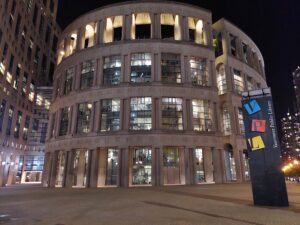Thinking about how to analyze and help develop a neighbourhood, a district, or an urban community of any size? Here are some ideas based on systems theory.
And stay tuned for my next two posts that demonstrate how these concepts are put into practice through a variety of urban agendas.☺
Studying the sustainability of a human settlement requires viewing it as a complex, adaptive, and networked system that involves interdisciplinary study through the lens of fields such as sociology, economics, anthropology, ecology, engineering, planning, agronomy, and political science. Elinor Ostrom pioneered the analysis of socio-ecological systems (SES) such as a city by proposing a framework that emphasizes the complex nature of SES and the need to consider all of the system’s levels, components, and external settings in sustainability decision-making. Informed by her work, an urban system can be conceptualized as comprising four interconnected components that interact across spatial and temporal scales: material and energy flows, urban infrastructure and form (including urban natural environment), governance networks, and socioeconomic dynamics.
The study of urban systems is particularly connected to such concepts of ecological systems as stocks and flows, nestedness, feedback loops, non-linearity, interdependence and connectivity over time, complexity, regeneration, and adaptive ability and management. Donella Meadows emphasizes the possibility to increase a stock not only by increasing the inflow but also by decreasing the outflow. In today’s resource-dependent and extractive cities, this means that an obvious solution would be to decrease resource consumption instead of increasing their extraction while potentially enhancing quality of life.
An urban system is not linear or hierarchical, rather it is nested, i.e., containing sub-systems, embedded in larger systems, and interacting across components, time, and space. Fluctuations in one urban community asset, for instance through policy, can affect other assets or interconnected systems. An example would be waste management: a whole-systems approach would comprise all conceivable stages of waste management and take into account potential impact on other parts of the community.
Urban systems are also characterized by feedback loops that occur when a persistent behaviour affects the flows or trends while changing the stock; positively if it amplifies change and negatively if it preserves status quo or reduces the intensity of change. Urban feedback loops may occur for instance when addressing chronic issues requires the development of new types of governance to adopt and implement new policies. Redundancy – or diversity in assets and land-use forms – is key for a resilient urban system with minimal feedback loops that result in negative outcomes.
A framework that sees the city as an ecosystem and studies the flows of urban energy and resources is based on the concept of urban metabolism, propagated mostly by McKinsey & Company and the World Future Council. It is “the sum total of the technical and socio-economic processes that occur in cities, resulting in growth, production of energy, and elimination of waste”. Urban metabolism studies demonstrating the ever-increasing demand for natural resources in cities have inspired sustainability and resource efficiency initiatives worldwide.
Bibliography
Brugmann, J. (2015). The Urban Productivity Imperative. In The Productive City: Growth in a No-Growth World (pre-publication draft). The Next Practice Ltd.
Cumming, G. S., Olsson, P., Chapin, F. S., & Holling, C. S. (2013). Resilience, experimentation, and scale mismatches in social-ecological landscapes.Landscape Ecology,28(6), 1139–1150. https://doi.org/10.1007/s10980-012-9725-4
Ellen MacArthur Foundation. (2013). Towards the Circular Economy vol 2—Opportunities for the consumer goods sector. https://doi.org/10.1162/108819806775545321
Girardet, H. (2013, June 10). Sustainability is unhelpful: We need to think about regeneration.The Guardian.
Girardet, H. (2015). Creating Regenerative Cities. Routledge.
Kennedy, C., & Hoornweg, D. (2012). Mainstreaming Urban Metabolism.Journal of Industrial Ecology,16(6), 780–782. https://doi.org/10.1111/j.1530-9290.2012.00548.x
McGinnis, M. D., & Ostrom, E. (2014). Social-ecological system framework: Initial changes and continuing challenges.Ecology and Society,19(2). https://doi.org/10.5751/ES-06387-190230
Meadows, D. H. (2008). Thinking in Systems—A primer. Earthscan Publications Ltd.
Meerow, S., Newell, J. P., & Stults, M. (2016). Defining urban resilience: A review.Landscape and Urban Planning,147, 38–49. https://doi.org/10.1016/j.landurbplan.2015.11.011
Moore, J., Kissinger, M., & Rees, W. E. (2013). An urban metabolism and ecological footprint assessment of Metro Vancouver.Journal of Environmental Management,124, 51–61. https://doi.org/10.1016/j.jenvman.2013.03.009
Neuman, M. (2005). The Compact City Fallacy.Journal of Planning Education and Research,25(1), 11–26. https://doi.org/10.1177/0739456X04270466
Newman, P., & Jennings, I. (2008). Cities as sustainable ecosystems: Principles and practices. Island Press.
OECD. (2015). OECD Green Growth Studies: Material Resources, Productivity and the Environment.
Ostrom, E. (2009). A general framework for analyzing sustainability of social-ecological systems.Science,325(5939), 419–422.
Roseland, M. (2012). Toward Sustainable Communities: Solutions for Citizens and Their Governments(4th ed.). New Society Publishers.
Uphoff, N. (2014). Systems thinking on intensification and sustainability: Systems boundaries, processes and dimensions.Current Opinion in Environmental Sustainability,8, 89–100. https://doi.org/10.1016/j.cosust.2014.10.010

















